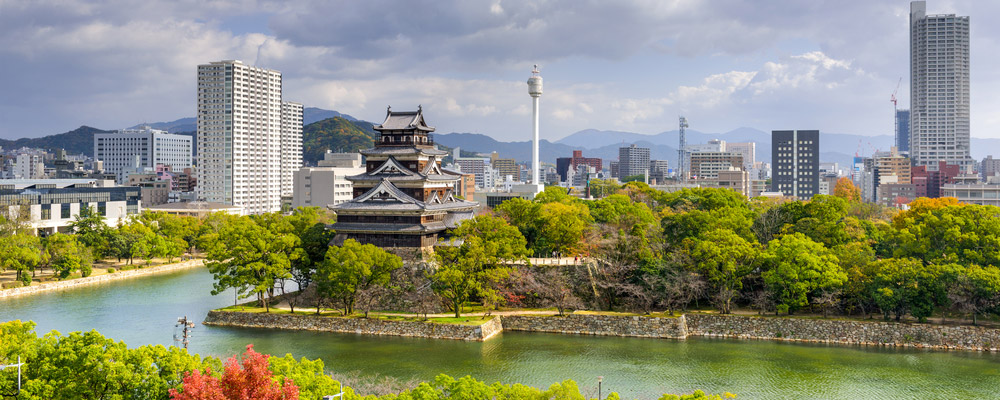Hiroshima Travel Guide

 Overview
Overview
Hiroshima is a large city on the island of Honshu that became renowned around the world for being the site where the first atomic bomb was dropped, during World War II. It was left in terrible condition, with the majority of the city being destroyed and several thousands of people losing their lives. The Genbaku Dome (A-Bomb Dome) was the only building left standing and still stands today.
Today, Hiroshima is one of the country’s most visited cities, welcoming several hundred thousand foreign tourists every year.
 When To Go
When To Go
- Springtime (March – May) in Hiroshima is a season filled with activities, particularly cherry blossom viewing in various spots and the Hiroshima Flower Festival during the Golden Week.
- Despite the high temperature and humidity, summer (June – August) in Hiroshima is celebrated with a number of events and festivals, such as the annual Hiroshima Peace Memorial Ceremony and Peace Message Lantern Floating Ceremony, and the Mihara Yassa.
- Autumn (September – November) in Hiroshima sees many events and festivities, such as the harvesting of different crops, fruit picking events, autumn leaves viewing, and the Saijyo Sake Festival.
- In winter (December – February), it does not snow a lot in Hiroshima, especially in the south, but it holds illumination events throughout the holidays.

Hiroshima Castle

Memorial Park in Hiroshima
 Things To See
Things To See
Explore the Peace Park
A prominent landmark of Hiroshima, the Peace Park covers a vast area, including the Peace Memorial Museum, the A-Bomb Dome (a world heritage site), Children’s Peace Monument with thousands of handmade paper cranes, landscaped gardens, and several other statues and monuments.
Check out the Shukkein Garden
The Shukkein Garden consists of numerous mini-gardens that depict mountains, valleys, rainforests and other landscapes. It is about four hundred years old now, and also includes a pond and some tea houses with fantastic views of the beautiful gardens.
Visit the Hiroshima Castle
Also known as the Carp Castle, the Hiroshima Castle is a five-storey fixture located in the city centre. It was constructed in 1589 and consists of a vast garden and a moat.
Tour the Mazda Museum
Hiroshima is where the headquarters of the Mazda Motor Corporation is located, and its economy is largely reliant on the automobile company. Visitors who want to learn how Mazda produces its cars should book a guided tour at the museum via email or phone (check the Mazda website for more details on how to make a reservation). The tour also offers a look at the history of Mazda, the different technologies it has developed through the years, and the many automobile models it has developed since it was founded in 1920.
See Hijiyama-Koen
A park just outside of the city centre. Around its ponds and paths are full of runners, walkers, families and visitors. A great park to take a stroll before visiting Hiroshima City Museum of Contemporary Art at the top of the park.

Miyajima – ©JNTO

Atomic Bomb Dome
 Where To Explore
Where To Explore
- Hondori Street – Located in the downtown area, Hondori Street is a covered pedestrian path that is lined with many restaurants and stores on both sides. It stretches about 500 metres to the east, beginning around the Peace Park vicinity.
- Okonomimura – Towards the end of Hondori Street lies the Okonomimura, or Okonomiyaki Village. It is an area where you can find many restaurants and diners that prepare all sorts of okonomiyaki, a type of Japanese food made by pan frying batter and cabbage, and topped with vegetables and other ingredients.
- Miyajima – While not in Hiroshima City itself, a side trip to Miyajima is a must for everyone already in the area. It is an island that can be reached by train, boat and ferry from downtown Hiroshima in less than one hour. Among its top attractions are the Itsukushima Shrine, Senjokaku, and Mount Misen (A world heritage site that is believed to be the island where the Gods dwell.) – You can read more about how to get to Miyajima using your JR Pass here
 Getting Around
Getting Around
Hiroshima serves eight tram lines (the largest tram network in Japan), a JR tourist loop bus, and several local buses. Walking is also an option to see more of the city up close.










